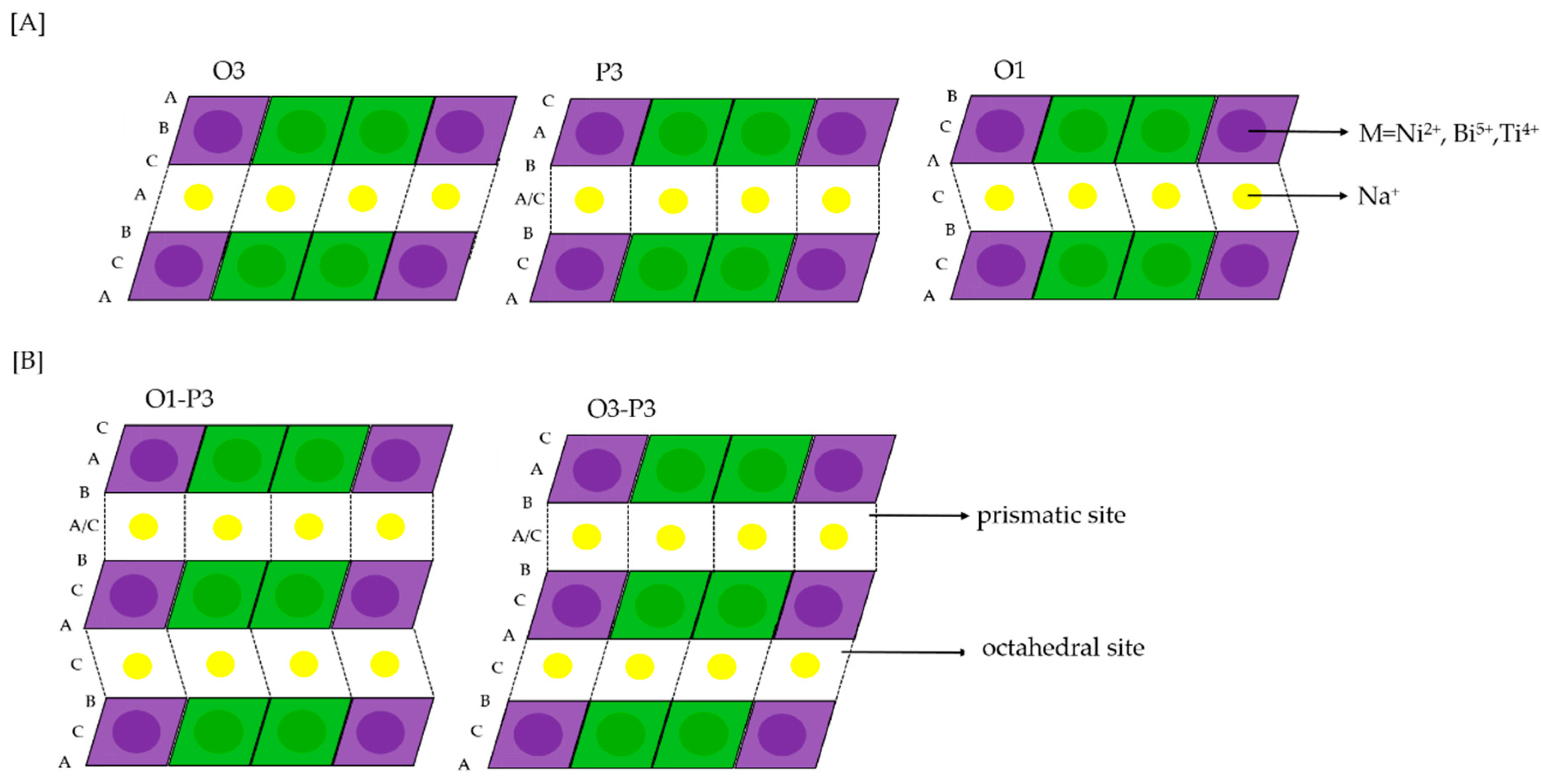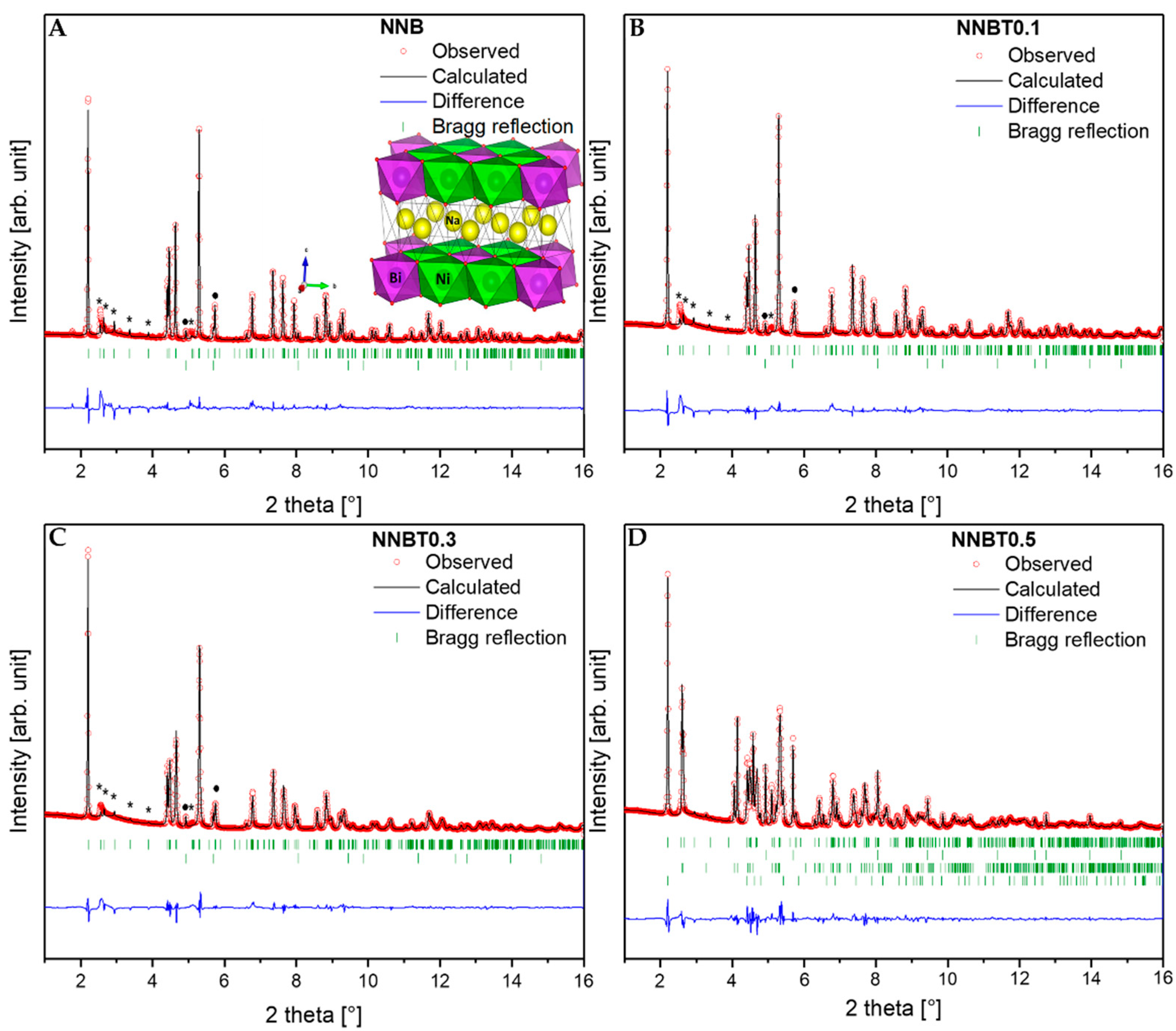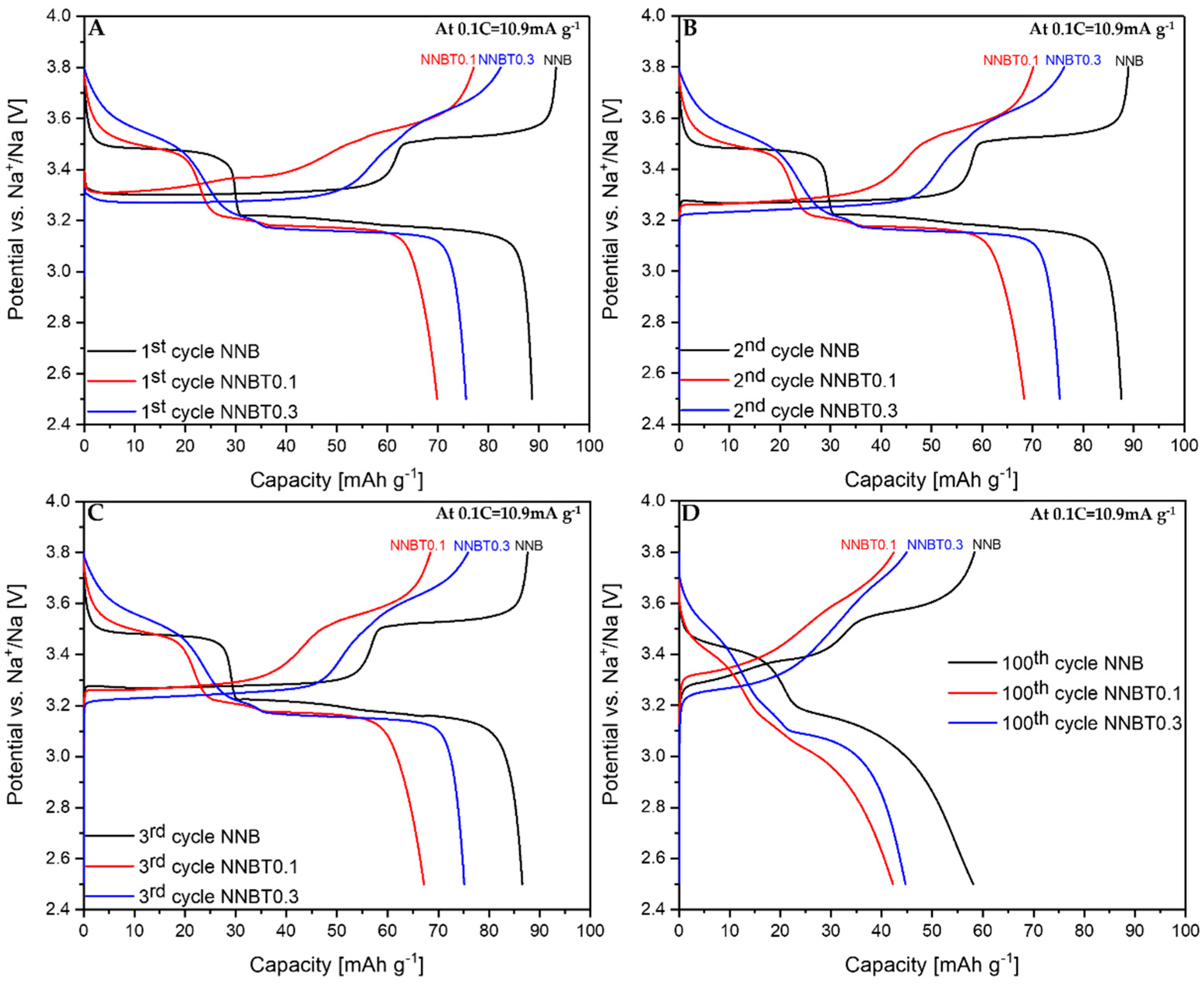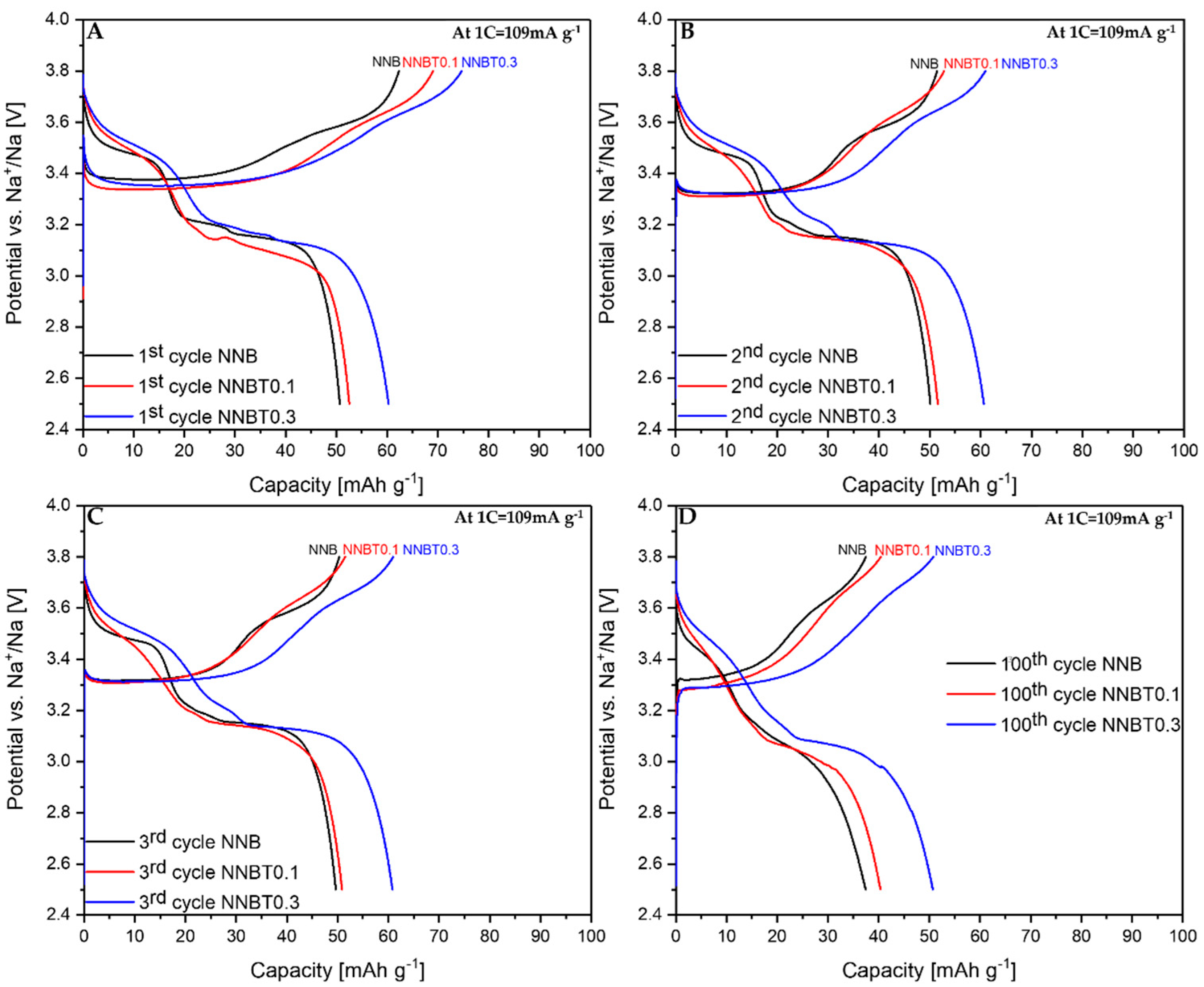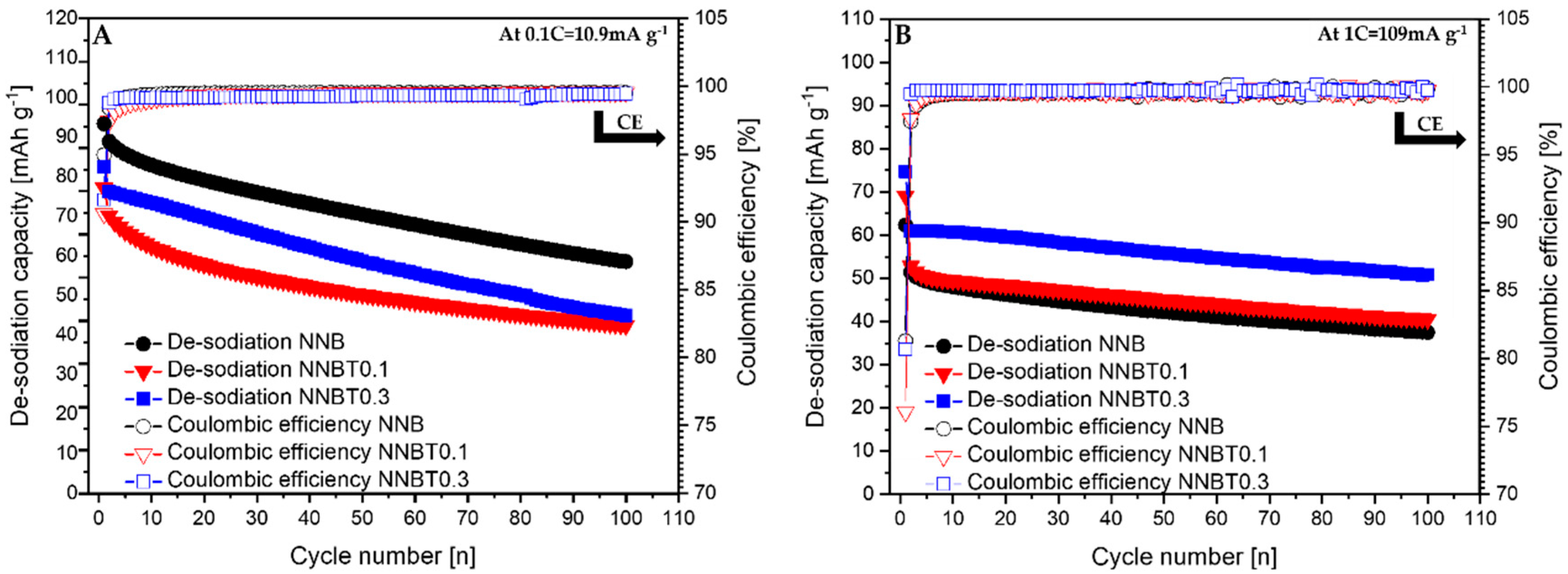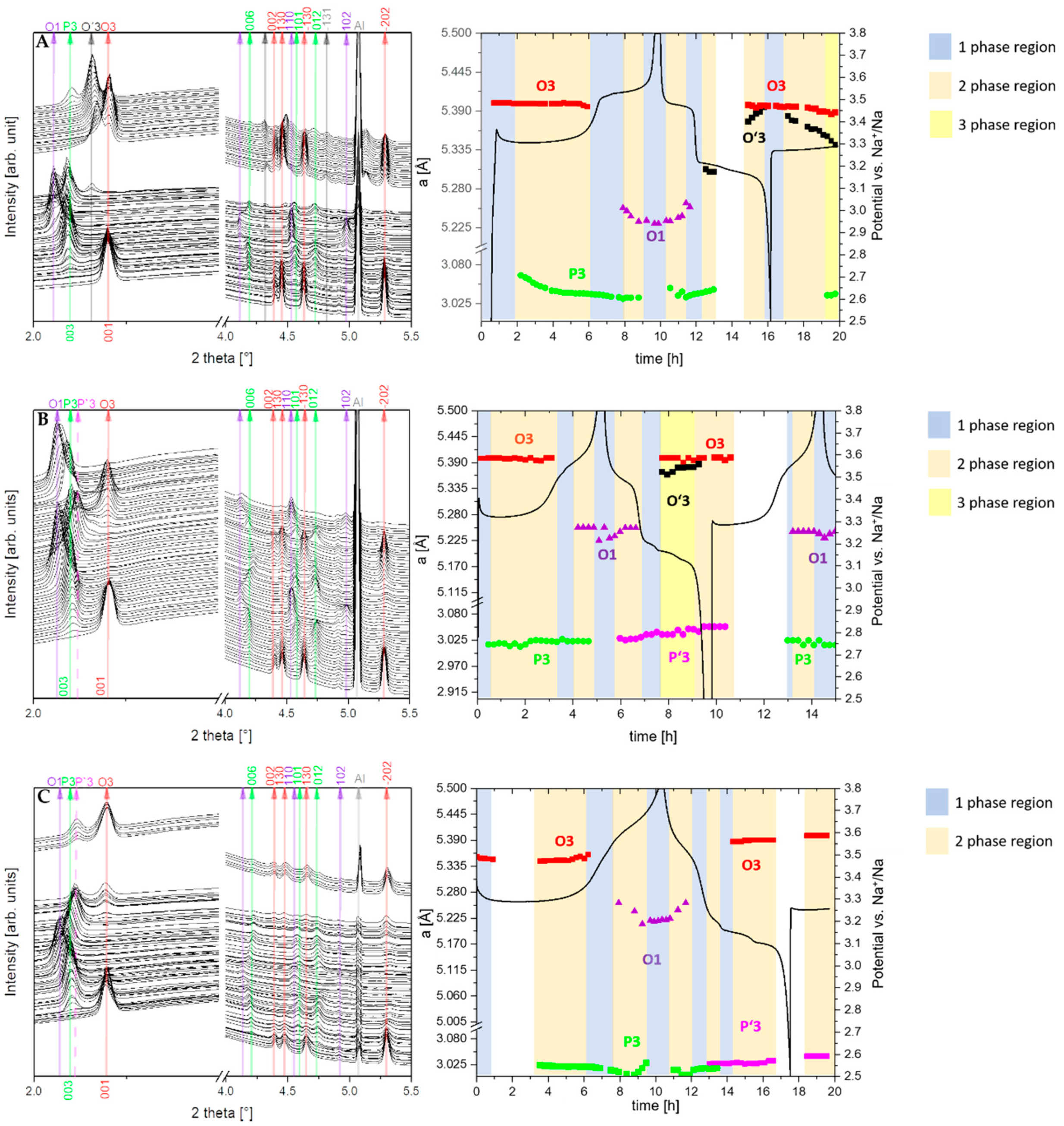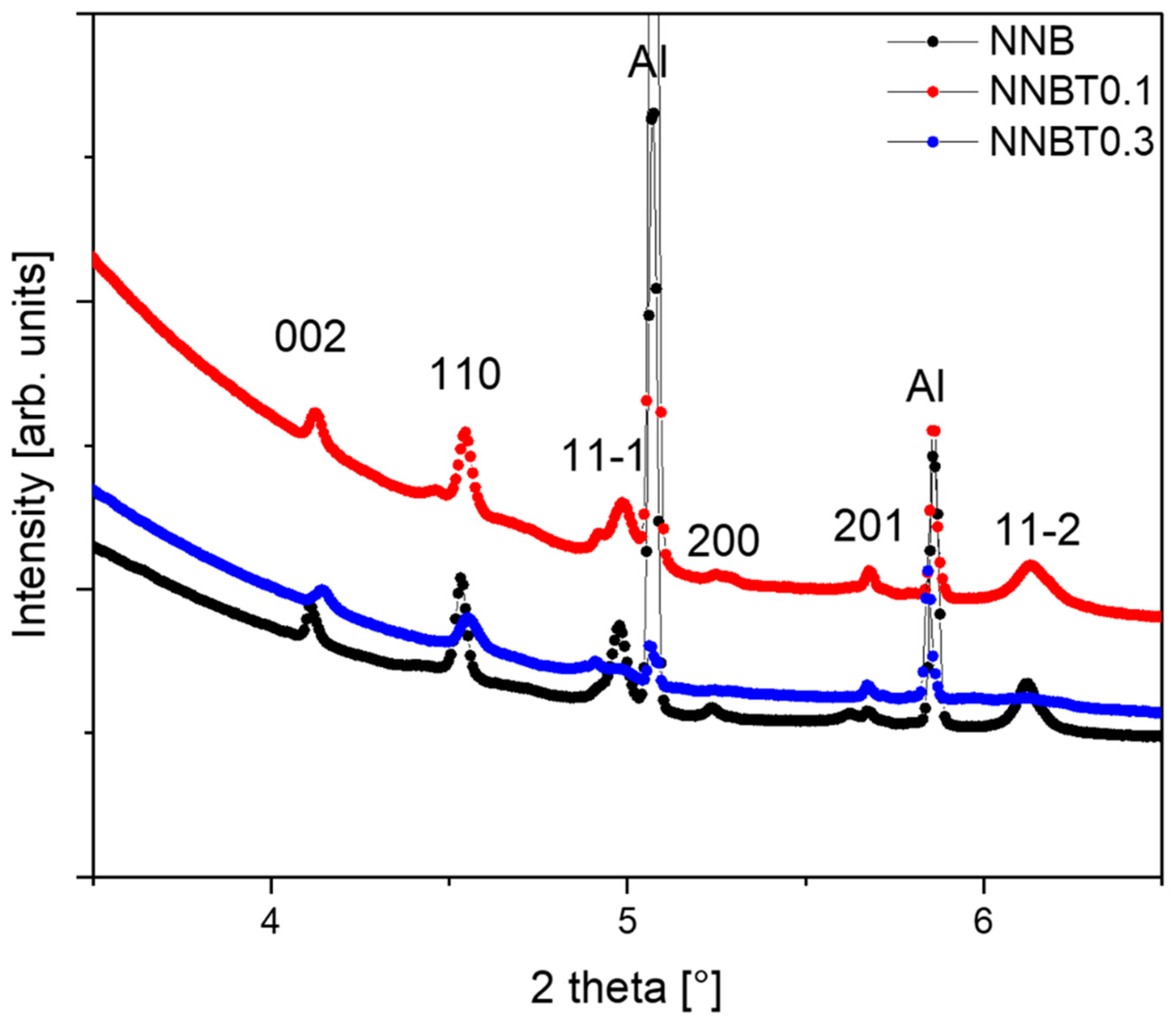1. Introduction
Research on post-lithium energy-storage devices is indispensable, as the high need for lithium will continuously increase throughout the period of 2025 to 2050 [
1]. Therefore, alternative storage devices, based on more abundant elements, are crucial for the progressing electrification. Sodium could be a suitable option, showing similar chemical properties as lithium [
2]. Among many candidates for positive electrode materials, the most studied ones are layered sodium transition metal oxides [
3]. Those layered transition metal oxides with the general formula NaT
MO
2 (T
M = Cr, Co, Fe, Mn, Ni, Ti, V) are characterized by their basic structure, facile synthesis and high charge storage capacity [
4]. For example, NaNiO
2 shows an excellent initial desodiation capacity of 147 mAh g
−1 [
4]. However, it has low cycling stability and multiple phase transformations, which is presented as a series of five plateaus between 2.0 V and 4.5 V vs. Na
+/Na during desodiation [
5]. These features make it unsuitable for battery applications. Improvements of the cycling stability and rate capability [
4,
5] of NaNiO
2 were achieved by substitution of 50% nickel with inactive Ti that led to phase transition suppression and only one remaining transformation (O3-P3) upon cycling [
6]. These phases are distinguished according to the classification for layered oxides [
7,
8], primarily in terms of the oxygen coordination of sodium-ions, which is prismatic (P3) or octahedral (O3). The digit “3” indicates the number of transition metal layers with different type of O stacking in a single cell unit (
Figure 1). The structure can be stabilized and phase transformations can be suppressed by the addition of another suitable element to the transition metal layers [
7]. This strategy was transferred to the promising Na
3Ni
2BiO
6 positive electrode material. Na
3Ni
2BiO
6 forms a honeycomb-type superstructure with a high degree of order due to the difference in the charge and size of the ions [
9]. Each pentavalent Bi
5+ (0.76 Å) forms a BiO
6 octahedron and is surrounded by six edge-sharing NiO
6 octahedra with divalent Ni
2+ (0.69 Å) [
9]. Na
3Ni
2BiO
6 can achieve a theoretical capacity of 109 mAh g
−1 [
9], corresponding to the oxidation of nickel from Ni
2+ to Ni
3+, while Bi
5+ is inactive during cycling. Nevertheless, it suffers from multiple phase transformations of O3-P3-O1 during desodiation (
Figure 1).
The first sodiation step of Na
3Ni
2BiO
6 leads to an additional O’3 phase, which results in the O3-O’3-P3-O1 transformation [
9,
11,
12,
13]. The multistep phase transformation causes a lattice structure reorganization, which results in low cycling stability [
5,
6]. There are two ways to suppress the phase transition of the honeycomb layered Na
3Ni
2BiO
6 structure: firstly, nickel-ion substitution, secondly—inactive bismuth substitution. Wang et al. suppressed some phase transformations of Na
3Ni
2BiO
6 by substituting nickel with copper (Cu
2+ 0.73 Å), magnesium (Mg
2+ 0.72 Å) and zinc (Zn
2+ 0.74 Å) [
13]. The suppression of the high-potential P3-O1 phase transition was successfully achieved, but the electrochemical reaction became more irreversible, probably through the breakage of charge balance and huge structure strain in this ordered structure. Despite the fact that the presence of Ti on the 3d metal positions in the structure of layered oxides is beneficial for the cycling stability [
7], there is no information in the literature about the influence of a Ti additive on the properties of the honeycomb structure. Therefore, our work is based on mixing two state-of-the-art systems: O3-NaNi
0.5Ti
0.5O
2 and O3-Na
3Ni
2BiO
6 with honeycomb structure [
6,
9]. The present work includes the synthesis of several compositions obtained by the replacement of Bi
5+ (0.76 Å) and Ni
2+ (0.69 Å) by the appropriate stoichiometric amount of Ti
4+ (0.61 Å). It is revealed the formation of a region with solid-solution in the two-component system NaNi
0.5Ti
0.5O
2 (R-3m)-Na
3Ni
2BiO
6 (C2/m), where only the Na
3Ni
2BiO
6 structure with the space group C2/m can be recognized. By inserting Ti into the honeycomb structure, the capacity at high currents is enhanced and the kinetics is improved because of two effects: the suppression of a P3-O1 phase transition during desodation and the exchange of an intermediate O’3 phase by a P’3 phase during the first sodiation. The P’3 phase is more favourable for the Na
+-ion diffusion, caused by a better diffusion ability of Na
+-ions through prismatic sites in comparison to the octahedral ones [
14].
3. Results
Diffraction patterns of NNB, NNBT0.1, NNBT0.3 and NNBT0.5 are presented in
Figure 2A–D and the corresponding structural information are listed in
Table S1. Based on the Rietveld refined structure parameters, NNB, NNBT0.1 and NNBT0.3 can be indexed in the monoclinic structure with the space group C2/m (Rp: 8.45, Rwp: 13.6 for NNB; Rp: 6.37, Rwp: 9.56 for NNBT0.1; Rp: 5.72 Rwp: 8.07 for NNBT0.3). All samples contain 3–14% NiO (marked with a dot) as an impurity. The presence of such NiO impurities seems unavoidable, which is consistent with the available literature [
11,
20]. The (Bragg) reflections shift to a higher scattering angle 2θ with increasing Ti content. This indicates a decrease of the cell volume with increasing Ti content. The calculated lattice parameters, shown in
Figure S1, support the assumption of an almost linear volume reduction versus Ti content. In the solid solution system of Na
3Ni
2BiO
6—NaNi
0.5Ti
0.5O
2 with the morphotropic boundary, around 0.3 mol Ti (Na
3Ni
1.9Bi
0.8Ti
0.3O
6, NNBT0.3), the Vegard`s law is still fulfilled [
21]. However, NNBT0.5 consists of four-phases, which is caused by the exceeded Ti concentration for the formation of a solid-solution. According to the report of Seibel et al. [
15] and Wang et al. [
13], the area of superstructure reflections (marked with asterisks) is located at 2.5°–4.0° 2θ and arise due to a high order degree of Ni
2+ and Bi
5+ cations inside the slab of the honeycomb structure. The monoclinic C2/m space group is the most appropriate one to fit these superstructure reflections, consistent with prior single-crystal and powder diffraction investigations [
9,
15]. The superstructure reflections for the synthesized materials are nearly vanished and the Warren-type diffraction peak with an extended high-angle tail at 2.54° 2θ is found for NNB, NNBT0.1 and NNBT0.3, which is caused by the occurrence of stacking faults [
9,
13,
14,
15,
22,
23]. Asymmetrical peaks, which characterize such defects, are also present in the ordered phase, indicating that the ordering is not completely developed in all samples. The ordering in the 3d metal layers still exist when the high-level stacking faults along the c axis are present. As shown in
Figure 2A, six NiO
6 octahedra with common edge-sharing octahedra surround one BiO
6 octahedron, forming the superstructure lattice. The electrochemical performance of NNBT0.5 cannot be compared to the other materials as it has lost the single-phase honeycomb structure. The morphologies of all compounds were characterized by scanning electron microscopy (SEM) and are displayed in
Figure S2. The pristine material NNB is composed of plate-like 200 nm–800 nm particles. With increasing Ti content, the diameter of grains becomes smaller and the particles have irregular shapes in NNBT0.1 and NNBT0.3. The morphology does not change when further increasing the amount of Ti.
After the structure elucidation, electrochemical measurements were performed. Galvanostatic profiles of the 1st, 2nd, 3rd, and 100th cycle of NNB, NNBT0.1 and NNBT0.3 are illustrated in
Figure 3 at 0.1 C and in
Figure 4 at 1 C. The associated cycling stability curves and corresponding coulombic efficiency values at 0.1 C and 1 C are shown in
Figure 5.
During the first desodiation at 0.1 C, NNB delivers a capacity value of ~93 mAh g
−1 (
Figure 3A), which corresponds to the state-of-the-art literature values [
9,
13]. The Ti-substituted materials deliver ~77 mAh g
−1 (NNBT0.1) and ~82 mAh g
−1 (NNBT0.3) (
Figure 3A). NNB is characterized by two flat plateaus during the first desodiation at 3.33 V and 3.55 V. These redox potential plateaus are typical for sodium nickelate layered systems [
13]. The presence of plateaus indicates phase transformations occurring during the sodium extraction/insertion [
24]. The two Ti-substituted materials also show two plateaus during the first charging process. However, the plateaus of the Ti-containing materials are less pronounced than those of the NNB. During the following sodiation, all materials exhibit three plateaus, corresponding to the reduction of nickel from Ni
3+ to Ni
2+ [
9,
13]. The sodiation process in NNB is accompanied by more phase transitions in comparison to the desodiation step and it will be discussed in the further part of this work. NNB shows a capacity of ~89 mAh g
−1 during the first sodiation. The coulombic efficiency values increase from~95% (1st cycle) to ~99.5% (20th cycle). The first sodiation capacity of NNBT0.1 is ~70 mA g
−1 with a coulombic efficiency (at the first cycle) of ~91%, which increases to ~99.4% during further cycling. The coulombic efficiency of NNBT0.3 is initially ~92% and raises after 20 cycles to ~99.2%. During the first desodiation, an overpotential can be seen for all electrodes (
Figure 3A and
Figure 4A). The reason for this polarization could be a low intrinsic conductivity, which could be electronic or ionic [
20]. At a low current rate (0.1 C), the polarization decreases after the first cycle, whereas at 1 C the polarization remains upon cycling. However, it is evident that at 1C the polarization of the Ti-substituted samples is lower compared to the NNB reference. After 100 cycles at 0.1 C, the loss of capacity for all samples is ~40%. The desodiation capacity of NNBT0.1 after 20 cycles drops from ~77 mAh g
−1 to ~59 mAh g
−1, but slightly stabilizes in the further cycles. The desodiation capacity of NNBT0.3 drops linearly from ~82 mAh g
−1 to ~70 mAh g
−1 after 20 cycles. The electrode materials perform differently at 1 C. NNB has the lowest capacity with ~62 mAh g
−1 whereas NNBT0.1 delivers an initial capacity of~69 mAh g
−1 and NNBT0.3 of ~74 mAh g
−1. However, all cells significantly suffer from the first irreversible capacity loss. This high drop of capacity is also reflected in a low coulombic efficiency at the first cycle. The coulombic efficiency of all cells increases from ~80% to >99%. In total, all observed plateaus are nearly in the same potential range as measured at low current. Nevertheless, the cycle stability is improved in comparison to the low-rate performance. While at 0.1 C all materials lose about 40% of their capacity after 100 cycles, the loss at 1 C is ~27% for NNB, ~24% for NNBT0.1 and ~16% for NNBT0.3. The cycling stability is higher at high rates compared to the low rate. Among the three electrodes, NNB shows the highest capacity at 0.1 C and the lowest one at 1 C, which can be attributed to a lower electrical conductivity. We, therefore, highlight that the rate capability can be optimized via Ti substitution.
The cyclic voltammograms (CV) shown in
Figure 6A–D confirm the results obtained from GCPL experiments. The reduction process has a more complex reaction mechanism. The CV of NNB (
Figure 6A) shows two distinct oxidation peaks at 3.33 V and 3.55 V and the corresponding reduction peaks at 3.47 V and 3.21 V. There is a broad peak at 3.1 V (
Figure 6A), which is situated near the peak at 3.21 V and it is in agreement with the appearing of the phase transition O’3–O3 during sodiation. An additional formed phase can prevent attainability of the thermodynamic equilibrium. The sequence of several successive phase transitions is typical for NaMO
2 layered cathode materials and can be a reason for the huge potential drop during the sodiation process [
12]. The mentioned broad peak at 3.1 V in NNB becomes sharp and distinct by Ti substitution, which suggests better kinetics. However, NNBT0.1 and NNBT0.3 have a broader peak at 3.55 V as well as an additional peak at 3.5 V, which is not present in NNB. The peak area ratios and peak shift between oxidation and reductions for NNB and NNBT0.1 are quite similar, whereas for NNBT0.3 each CV curve is perfectly overlapped without any shift in the voltage range between 2.5 V and 3.8 V [
25]. The broad oxidation peak at 3.55 V in NNBT0.1 has also become wider in NNBT0.3, which indicates a phase transition suppression with a higher amount of Ti. To better understand the associated phase transformation,
in operando synchrotron radiation diffraction was performed.
In all compounds, the desodiation of the O3 phase starts with a solid solution mechanism (single phase), which is marked by a blue region in the diagram for the NNB (A), NNBT0.1 (B) and NNBT0.3 (C) compounds (
Figure 7A–C). In these regions, the a and b parameters are decreasing and the c parameter is increasing. The solid solution regions are followed by two-phase regions (coloured in orange), where the O3 phase is exchanged by P3. In the two-phase O3-P3 region, the parameters a, b and c of both phases are slightly changing. This is an indication for a non-equilibrium state, that allows describing this region with both mechanisms: solid-solution reaction and two-phase reaction, which are observed concurrently. The O3-P3 two-phase reaction at 3.31 V is caused by the TMO
2 slabs gliding without breaking the TM-O bonds during the desodiation process. At the same time, the oxygen packing of the TM layers changes from “AB CA BC” to “AB BC CA” [
26]. This means that the phase transition is a reconstructive one, therefore necessarily of 1st order and prone to coexisting phases. This phenomenon demonstrates that the coexistence of the two phases is the main reason for the voltage plateau at 3.31 V (
Figure 3 and
Figure 4). The trend of parameters change in the O3-P3 two-phase region (
Figure 8) demonstrates that this transition happens through several states. In the NNB compound, the a, b, c and β parameters slowly decrease until the tipping point—60%
w/
w P3 (
Figure 8A–D). Thereafter, the a and c parameters keep on decreasing, while b starts to increase (
Figure 8A–C).
Figure 8E illustrates the mirror-like character of the unit cell volume change of the O3 NNBT0.3 phase in comparison to NNB. For NNBT0.1 and NNBT03, parameters a and c are increasing, while b is decreasing. The Ti substituted compounds have a bigger fluctuation of parameters after tipping points, which move to the 70%
w/
w P3 for NNBT0.1 and 75%
w/
w P3 for NNBT0.3 (
Figure 8A–D). It can be proposed as the inception of intermediate P’3 phase. At the same time, the tipping point 60%
w/
w P3 in the NNB indicates that the O3 layered structure starts to strain and then transforms to the O’3-type structure, which occurs during the sodiation process. Simultaneously, the a, b, and c parameters of the rhombohedral P3 phase are monotonically decreasing in the O3-P3 two-phase region (
Figure S3). The lattice parameter c also has a tipping point at 60%
w/
w P3 (
Figure S3B). Furthermore, at the higher potential (3.52 V), the materials undergo another two-phase transition from the P3 phase to the O1 phase. The presence of Ti in the NNBT0.1 and NNBT0.3 structures can partly suppress the P3-O1-P3 transformation. In this case, the broadening of the O1 phase reflection can be observed in the diffraction pattern (
Figure 9). This phase transition for the NNBT0.3 composition is accompanied by the appearance of a structural disorder O1 phase on the alternating TMO
2 and Na-octahedral layers called “stacking faults”. As a result of the stacking faults, the
11-l reflections become broader or disappear. When the NNB sample is sodiated to 2.5 V, it transforms back to the O3 phase, recovering the initial structure.
In operando investigation shows that different ratios of integrated Ti-cations on the metal layer can have an influence on the phase transitions upon electrochemical reaction. Although the desodiation process is quite similar for all compositions, a difference in the phase transition mechanism appears during the sodiation process. For the Ti-free structure NNB, the transformation during sodiation follows the sequence O1-P3-O’3-O3 (
Figure 7A). Both O’3 and O3 phases are monoclinic C 2/m with slightly different unit cell parameters. During the second cycle, in the desodiation process, it is possible to recognize the coexistence of 3 phases (the yellow region in the diagram) (
Figure 7A): O3, O’3 and P3. The thermodynamic equilibrium is not reached due to slow Na
+-ion diffusion and it can be the reason for the poor cycle stability. For NNBT0.1, the sodiation mechanism is different and the transformation follows O1-P’3-O’3-O3 (
Figure 7B). NNBT0.1 shows the relatively poorest coulombic efficiency. The reason is a not wholly transformed O’3 intermediate phase to the new intermediate P`3 phase. This causes, that the active material do not return to the initial state after one cycle and it is composed by multiple phases. The new appeared P’3 phase (a = 3.0277(3), c = 16.821(4)) crystallizes in the same rhombohedral R-3m space group, like P3 (a = 3.0188(3), c = 16.943(3)). Difference in the parameters can be explained by less Na
+ content in the P3 phase compared to the P’3 one. The presence of a small amount of O’3 structure leads to the formation of a three-phase region (P’3, O’3, O3) during the first sodiation process. The presence of the three-phases can be correlated to the lowest value of specific capacity. For the composition with the highest Ti content NNBT0.3, the absence of the O’3 phase (
Figure 7C) in the sodiation mechanism improves the kinetics of the electrochemical reaction and the thermodynamic equilibrium can be reached during phase transformations O1-P3-P’3-O3. The phase transition P3-P’3 starts at 3.2 V during the sodiation process and corresponds to the appearance of a new reduction peak on the CV (
Figure 6C). Both phases create the small two-phase region, where first-order phase transitions exhibit a discontinuity in the first derivative of the free energy with respect to some thermodynamic variable. The phase P’3 is an intermediate state between the P3 and O3 structure. The appearance of the P’3 phase was also previously reported for the Na
3Ni
2RuO
6 composition [
26]. Li et al. [
26] suggest that the O3 to P3 phase transition occurs as a gradual change process, where various intermediate phases such as O′3 and O′′3 or P’3 phases can exchange each other or coexist. In the case of the Ti-containing material compositions, the exchange of the O’3 intermediate phase by the P’3 phase is observed. Predictably, the Na
+-ion diffusion in the material with P’3 intermediate is facilitated. The sodium ions are expected to have a better diffusion ability through prismatic sites in comparison to the octahedral ones [
14]. Another factor, which improves the cycling stability is the suppression of phase transitions at high potentials. Zhao et al. [
27] demonstrated that such a phase transition can be suppressed by doping another O3-type Ni
2+-based cathode with 3d metals (Cu, Zn, Co, Mn). The addition of Ti to the NNB honeycomb structure partially suppresses the P3-O1-P3 phase transition. Thereby, the Ti substituted honeycomb structure improves the kinetics due to the presence of a P’3 intermediate phase with Na-prismatic layers resulting in superior better capacity retention at higher current and absence of three phase regions in the electrochemical mechanism of the NNBT0.3 material.
